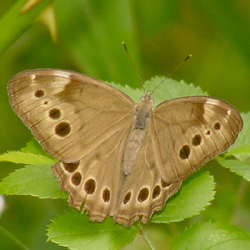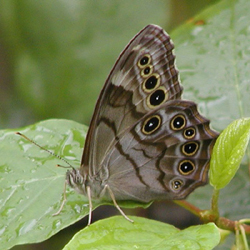Butterfly Atlas
Find a Butterfly
Northern Pearly Eye
Enodia anthedon
Named
Clark, 1936

Taxonomy & Nomenclature
This species was distinguished from its southern relative, Southern Pearly Eye (E. portlandica) in 1971. Prior to this work, authorities recognized only E. portlandica.
Identification
Wingspan: 1 3/4 - 2". Of the larger Massachusetts satyrids, this species is distinguished by its deeply scalloped hindwings and the presence of large, ovoid eyespots on all wing surfaces. Above, tan with 5 eyespots on each hindwing. In addition to the striking eyespots the pearly eye typically has a lavender cast in contrast to the tan coloration of the Browns (Satyrodes) with which it is most likely to be confused.
Distribution
Southern Saskatchewan east to Newfoundland and south through the Appalachians to Arkansas. In New England portions of eastern and central Maine, throughout New Hampshire and Vermont, and large areas of Massachusetts and Connecticut. Generally absent from southeastern areas of the region.
Status in Massachusetts
This species is found in small numbers at scattered localities across much of the state. As is clearly indicated by the accompanying distribution map, Northern Pearly Eye is largely absent from the southeastern region of the state. Scudder (1889), in his account of E. portlandica, states that "within the limits of New England it is very rare," and mentions fewer than six locales for this state, all in western Massachusetts. Scudder worked during the period of maximum forest clearing here. An increase in numbers and expanding range for this species seems consistent with the fact that much of the state has become reforested.

Flight Period in Massachusetts
One flight: late June through early August. Extreme dates: 23 June 1991, BMBS (Worcester Co.), T. Dodd, and 23 September 1987, Wilmington (Middlesex Co.), S. Goldstein.
Larval Food Plants
Mainly woodland grasses: Long-awned Wood Grass (Brachyelytrum erectum), Bottlebrush Grass (Hystrix patula) and Purple Oats (Schizachne purpurascens) are the most likely food plants in New England. Also reported from Reed Canary Grass (Phalaris arundinacea), an abundant introduced grass of wet soils.
Adult Food sources
Tree sap and fallen fruit are probably the main food sources. Rarely seen at flowers. Recorded nectaring at viburnum during Atlas years.

Habitat
Closely associated with woodland habitats, especially edges and openings.
Life Cycle
EGG: White to greenish white; dome shaped and smooth. OVIPOSITION: Eggs laid singly on grass host plant. LARVA: Yellow green with dark green and yellow stripes; head with pair of red tipped horns, tail tip pinkish red. CHRYSALIS: Green to blue green with cream colored highlights on head and wing cases. OVERWINTERING STAGE: Young larva.
During their mid summer flight period adults are often observed perched on tree trunks or limbs or moving slowly through the understory. In concert with this species preference for shadowy, low light situations, courtship often takes place at twilight.
Account Author
Richard K. Walton



